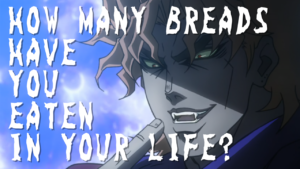Let’s learn Japanese with Tanjiro’s quote from Demon Slayer (Kimetsu no Yaiba, 鬼滅の刃).
CONTENTS
Video
Tanjiro’s Quote
Japanese: 俺と禰豆子の絆は誰にも引き裂けない!
Romaji: ore to nezuko no kizuna wa dare nimo hikisakenai!
English: No one can tear apart the bond between Nezuko and me!
Analysis
俺 (noun) means “I” or “me” in a manly way.
と (connecting particle) means “and”, used to connect nouns.
禰󠄀豆子 (noun) is the name of his sister.
の (modifying particle) is used to add details to the following noun which is 絆 (noun) meaning “bonds” or “strong connections” between two or more people.
So 俺と禰󠄀豆子の絆 means “the bond between Nezuko and me”.
And は (topic particle) indicates the topic of the sentence.
誰も followed by verb negative form (〜ない/〜ません) means “no one does something”. For example, 誰も知らない meaning “No one knows”, 誰も否定しない meaning “No one denies”.
引き裂けない is the negative form of 引き裂ける which is the potential form of 引き裂く meaning “to tear apart”. So 誰も引き裂けない means “no one can tear apart”.
And the に particle is added for emphasis (NO ONE!). It can be used with verb negative & POTENTIAL form so you can’t say 誰にも知らない or 誰にも否定しない as the verbs are not potential.
Here are some examples,
誰もできない or 誰にもできない meaning “no one can do”
できない is the negative form of できる which is the potential form of する meaning “to do” so the に particle can be added for emphasis.
誰もわからない or 誰にもわからない meaning “no one can understand”
わからない is the negative form of わかる meaning “to understand” which itself has a sense of potentiality so the に particle can be added for emphasis.
Now I’ll also give you some tips about 絆 and 引き裂く.
絆 originally comes from ropes used to tie up animals and 引き裂く is the compound verb made up of 引く meaning “to pull” and 裂く meaning “to tear” or “separate”. So the image of 絆を引き裂く is like pulling apart a rope which connects two or more people.
Here are some examples with 絆:
固い絆 meaning “tight bond“
絆を結ぶ meaning “to tie a bond”
絆を強める meaning “to strengthen a bond”
And here are some examples with 引き裂く:
家族を引き裂く meaning “to tear a family apart”
心を引き裂く meaning “to tear one’s heart out”
手紙を引き裂く meaning “to tear up a letter”
Examples
絆 (bonds)
最近、家族の絆が弱まっている。
saikin, kazoku no kizuna ga yowamatte iru.
Recently, family ties are weakening.
私たちは強い絆で繋がっている。
watashitachi wa tsuyoi kizuna de tsunagatte iru.
We are connected with a strong bond.
スポーツを通じて、仲間との絆が深まった。
supōtsu o tsūjite, nakama tono kizuna ga fukamatta.
The bonds between friends were deepened through sports.
引き裂く (to tear apart)
その事件が二人の仲を引き裂いた。
sono jiken ga futari no naka o hikisaita.
That incident separated the two of them.
多くの家族が戦争によって引き裂かれた。
ōku no kazoku ga sensō ni yotte hikisakareta.
Many families were torn apart by the war.
彼のシャツをズタズタに引き裂いて、捨てた。
kare no shatsu o zutazuta ni hikisaite, suteta.
I tore his shirt into pieces and threw it away.
誰にも + Verb Negative Potential Form (No one can do …)
この暗号は誰にも解けない。
kono angō wa dare nimo tokenai.
Nobody can break this code.
あの車は誰にも止められない!
ano kuruma wa dare nimo tomerarenai!
No one can stop that car!
俺の仕事は誰にもできない。
ore no shigoto wa dare nimo dekinai.
No one can do what I do.
With Negative Potential Verb, 誰にも and 誰も are usually interchangeable.
However, when the verb takes the に particle as the indirect object marker, they are not interchangeable.
e.g. someone + に話す (to tell someone)
誰にも話せない。
dare nimo hanasenai.
I can’t tell anyone.
誰も話せない。
dare mo hanasenai.
No one can speak.
Also, when 誰も is used as the direct object of the following verb, you can’t replace it with 誰にも.
e.g. someone + を愛す (to love someone)
誰も愛せない。
dare mo aisenai.
I can’t love anyone
誰にも愛せない(?)
dare nimo aisenai.
No one can love (awkward expression)
Support Easy Peasy Japanesey
If you enjoy our content, please consider supporting Easy Peasy Japanesey. Your support will help keep us going. Thank you for your support!


